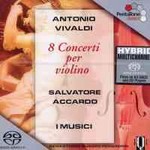
8 Concerti per violino
 $40.00
Out of Stock
$40.00
Out of Stock6+ weeks add to cart
VIVALDI
8 Concerti per violino
Savatore Accardo (violin) / I Musici
[ Pentatone SACD / Hybrid SACD ]
Release Date: Monday 1 June 2009
This item is currently out of stock. It may take 6 or more weeks to obtain from when you place your order as this is a specialist product.
After his Op. 6, Vivaldi´s concertos consist, almost without exception, of three movements (fast - slow - fast) and only a few works are preceded by a slow introduction.
Antonio Vivaldi's path through life was predestined. The highly talented child was taught to play the violin at a young age by his father Giovanni Battista, and, by the age of 10, was already playing occasionally in his father's orchestra in the Markusdom (= St. Mark's Cathedral) in Venice. For financial reasons, his father then decided his son would become a priest, at the time a highly respected choice of vocation. Following his ordination in 1703, Vivaldi remained a practising priest for only a short while, for reasons of health. That same year, he was engaged as "maestro di violini" (violin teacher) at the Ospedale della Pietà. The orphanage housed a few hundred children, most of whom were girls. A number of them, the "figlie di coro", also received - apart from basic schooling - specific musical training, either vocal or instrumental, at the conservatoire affiliated to the Ospedale. The performances given by these girls during the Sunday concerts were of a high standard. Vivaldi was responsible not only for rehearsals and performances, but also for providing the girls with compositions of his own - especially solo concertos, in which one instrument takes on the string orchestra, accompanied by the harpsichord, in a musical competition. After his Op. 6, Vivaldi´s concertos consist, almost without exception, of three movements (fast - slow - fast) and only a few works are preceded by a slow introduction. His concerto movements are based on the alternation of orchestral ritornels and solo sections, in which he - according to the formal structure employed - either provides the soloist(s) and the orchestra with the same themes, or differentiates between the thematic material for the soloist(s) and the orchestra. At times, he alternates his method per movement within a composition.
Tracks:
Concerto for violin, strings and continuo in C Op. 7/2, RV 188
Concerto for violin, strings and continuo in G minor, Op. 7/3, RV 326
Concerto for violin, strings and continuo in A minor, Op. 7/4, RV 354
Concerto for violin, strings and continuo in F, Op. 7/5, RV 285a
Concerto for violin, strings and continuo in B flat, Op. 7/6, RV 374
Concerto for violin, strings and continuo in G, Op. 7/8, RV 299
Concerto for violin, strings and continuo in B flat, Op. 7/9, RV 373
Concerto for violin, strings and continuo in F, Op. 7/10, RV 294a
